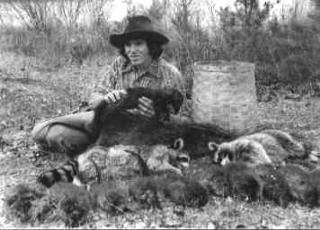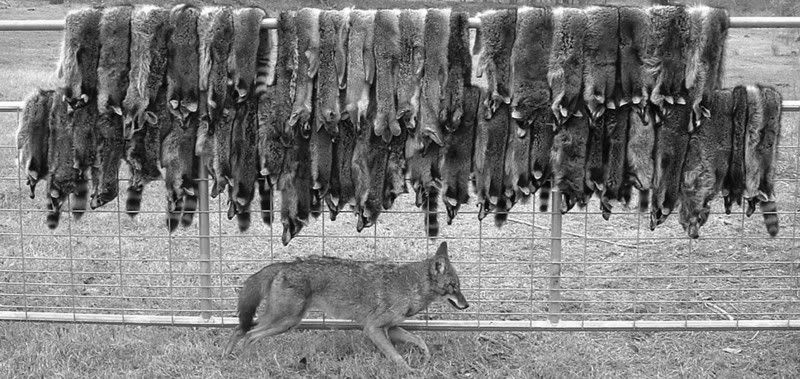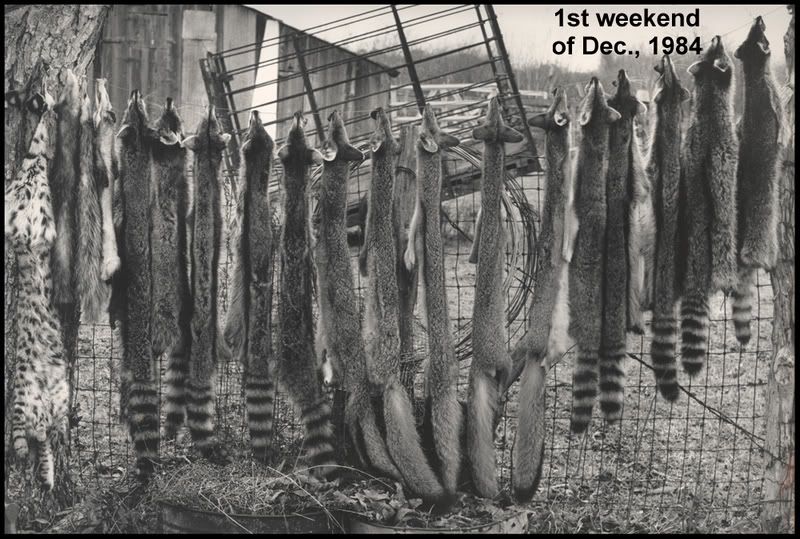

 The Accurate Reloading Forums
The Accurate Reloading Forums  THE ACCURATE RELOADING.COM FORUMS
THE ACCURATE RELOADING.COM FORUMS  Hunting
Hunting  Fur Hunting And Trapping
Fur Hunting And Trapping  I want to trap a few fox during deer season, how?
I want to trap a few fox during deer season, how?Go  | New  | Find  | Notify  | Tools  | Reply  |  |
one of us |
I will be spending sometime in N. Minnesota for deer season and we are seeing quite a few large red fox. I thought it would be fun to set a few traps when I get there and see what happens. I have no equipment and no knowledge, except I know the areas where I see them. Would someone here be willing to tell me the basics to get me started with a few traps or snares, whichever is more effective? So what type, where do I get them, how do I make the set, etc. Thanks. | ||
|
| one of us |
Fox are easy to catch. For reds, I'd go with a # 1.75 or #2 coilspring trap (www.rpoutdoors.com). For best results, you'll want to degrease your traps, let them sit outside for 5-7 days to get a light coating of rust and then dye them with one of the commercial logwood dyes. An 18" stake should suffice. On the RP site, you'll see quite a bit of lure and bait options. Every area is different in terms of what the animals prefer, but at that time of year, a food-based lure with maybe a hint of gland should work nicely in conjunction with one of the commercial baits. I prefer the simple dirt-hole set for fox. Instead of going into detail, do a quick search and you'll find a sketch that shows exactly how it is set up. Wear gloves and be careful not to elave any unnecessary human odor and you should do fine. Bobby Μολὼν λαβέ The most important thing in life is not what we do but how and why we do it. - Nana Mouskouri | |||
|
one of us |
Thanks Bobby. A few questions: 1. Which would you choose, 1.75 or 2 2. How do you degrease 3. How many sets would you put out and 4. Any tips on where to place them, fence rows, transition areas such as treeline to pasture, etc. | |||
|
| One of Us |
I can highly recommend Minnesota Trapline Products as your supplier. Give them a call and tell them what you want to do, they will help you. Not a bad idea to get a few books or videos on the basics of the subject when you buy the supplies. A couple good videos would be money very well spent, if you just buy a few traps and some lures with no instruction you will run into problems. There is a lot to this and you will need to spend some time doing it to figure it all out. There are lots of things you will have to learn...trap prep, trap bedding, trap anchoring, constructing the dirt hole set, location, location, location! Have fun! | |||
|
| one of us |
You don't say if you already have a trapping license or not, but it doesn't sound like it. You should consider doing it right the first time by taking the trapper education course ( Minnesota Trappers Association ). If you are going to spend any time setting traps then you owe it to yourself to get the most out of your time by learning everything from where to set your traps to how to skin your pelts. You could start with the Minnesota Trappers Association Trappers Manual . My biggest concern is that if not done right you could end up trapping and killing someone's pet or a non-target species. These types of incidents quickly lead to new calls for trapping bans. My secondary concern is that if it's not done right you are going to end up with poor catches and possibly ruined furs. Then of course there's the law - licenses, seasons and regulations. There are extra restrictions in NE Minnesota that you should especially be aware of (east and north of US 53) in place to avoid the accidental taking of Canada Lynx ( Mn Canada Lynx reg ). You might even catch yourself a game warden if not careful. While I'm not a trapper myself, I do hunt coyotes and fox for pelts. I do know a few trappers and can tell you that when done right it's a lot more work than one might think. I respect their dedication to the sport and the commitment to tradition that so many of them seem to have. If you are hunting for pelts and need some info on how to handle your take then I can highly recommend the DVD called "Practical Fur Handling" by T&M Outdoors (2006). It's got separate chapters on how to prep pelts of muskrat, mink, skunk, otter, raccoon, bobcat, fox, beaver, coyote. Just over 5 hours total and well worth the price even for one chapter. Finally, I can also recommend another good site for reference - it's here Trapper Talk . Good luck in any event. . "Listen more than you speak, and you will hear more stupid things than you say." | |||
|
| one of us |
Prewar70 wrote:
I prefer the 1.75, but either will do just fine. As to degreasing, there are a number of ways, but hot, soapy water and a good brush is what I generally do, though I have been known to take a new batch to the car wash... As to number of sets, that's difficult to say as I read the terrain and signs therein and calculate what can be reasonably taken out without overtrapping. Every situation is unique, so a specific answer here really would not help you. One thing I will mention: If I plan to take more than one animal of a species from a select area, I'll often make a secondary set within 50-75 feet of the first using a different lure/bait combo. I've scored countless doubles this way. When setting, you'll soon notice natural funnels in which the animals travel. You'll probably also notice the intersection of primary game trails. Check the tracks; read the sign. Set near these (but not on them) and keep the wind in mind. Once you locate these hotspots, you can come back to them year after year and enjoy repeated success. The pelts below were taken during a good weekend 2 seasons ago. I generally pick up a few more 'yotes, bu t there was no market for them in '06 (at least not from my area).  I am hoping the demand for coyotes is up this year as we have quite a few like this guy:  Bobby Μολὼν λαβέ The most important thing in life is not what we do but how and why we do it. - Nana Mouskouri | |||
|
one of us |
Bobby great information and thanks a lot for your willingness to help. I'm going to make a few phone calls today and get set up. I'll let you know how I do or if I have any other questions. If I catch a lynx by accident, I'm going to buy a lottery ticket too. | |||
|
one of us |
Ok everything is in the mail. Called minn trapline so I could keep the business in the state. I purchased 1/2 dozen Sleep Creek 1.74 square pan offset jaws, 3/8 x 18 rebar stakes, logwood dye, and his favorite fox lure and bait. Can't wait to get started. | |||
|
| one of us |
Sounds like you are all set. A couple things you will also need that can come from your local hardware store will be a mini-sledge hammer to drive in the stakes, a small garden spade and the 3-pronged cultivator to prepare your trap bed. (The graden tools run about $2 each at Wal-Mart) Here's hoping you do well and that we'll see some photos from your successful trapline. Bobby Μολὼν λαβέ The most important thing in life is not what we do but how and why we do it. - Nana Mouskouri | |||
|
| one of us |
OK, while I am feeling nostalgic, here's another primer for you: opening weekend's take from a short trapline in 1984.  Bobby Μολὼν λαβέ The most important thing in life is not what we do but how and why we do it. - Nana Mouskouri | |||
|
| One of Us |
Fish is a great lure for foxes.My foxes are somewhat lampshy owing to some pykies out with lurchers at all hours of the night. So I placed a few bits of out of date fish from thelocal fish shop where I know the foxes move and baited for a couple of days in each spot. I set up a high seat nearby to each spot and shot 7 foxes at dusk. I have to admit one came up behind and I just got that watched feeling.I turned around and foxy was staring up at me from the bottom of the high seat.He cooperated by moving off 25 yards to let me get a shot at him. Only 1 evening was a blank. I would suggest if you have deer around you make a little stile 18 inches high.The deer will over it and not get snared,a sad sight. | |||
|
| one of us |
SIKA98K- I think he is going to use coilsprings, so there's no need to worry with snares and non-target species. But that is a very good point you bring up. In fact, most companies selling snares also offer deer stops. Bobby Μολὼν λαβέ The most important thing in life is not what we do but how and why we do it. - Nana Mouskouri | |||
|
| One of Us |
I trapped fox for many years. come on over to pick up your shirts and I will show you how to make a dirt hole set and a flat set. | |||
|
one of us |
Been doing a little reading, do you guys use a piece of wax paper or coffee filter to cover the pan and inside of the jaws before covering with dirt? Also, it seems getting a firm set with the trap in the hole is important. Do you also fill in sifted dirt inside of the jaws before putting your wax paper over the pan? Seems some folks pay a lot of attention to this and others gloss over it. I degreased my traps in the dishwasher last night and they all ready started to rust in places. My wife asked me what in the heck was I pulling out of the washer this morning. Oh nothing honey, just some 1.75 coilsprings traps for mr. fox, that's all, what did you expect? I plan on putting them outside tonight to begin the rusting process. | |||
|
| one of us |
Giving the trap is solid bed is extremely important with light-footed fox. I do not use wax paper but do carry a ziplock of leaves in my backpack to use for covering the pan. Normally I never even have to use these as there are plenty where I trap. But I carry them just in case... I put a couple leaves over the pan and extending out a bit toward the jaws and then sift dirt over. If the dirt is particularly fine, I may use some leaves around the jaws as well. As to the dishwasher bit, that sounds like our household. I don't think anything surprises my wife anymore... Bobby Μολὼν λαβέ The most important thing in life is not what we do but how and why we do it. - Nana Mouskouri | |||
|
one of us |
Bobby do you fill dirt inside the trap to bring the level up BEFORE you put the leaves over the pan, then sift dirt over. Also, when you dig the hole, do you place the dirt on a tarp or by other means? And then do you place the dirt into the sifter with the trowel. Sorry for all the questions but if you could describe your dirt sifting and packing process that would be great. | |||
|
| One of Us |
I find that using a pinch of polyfill batting under the pan is a lot faster and easier to work with than a pan cover but that is a matter of personal choice. Try a few things and see what you like. You can buy a big bag of polyfill from a craft or fabric store. It also works great as a lure holder in the hole. It has no odor and will not hold water (and freeze)like a sponge. When you dig your trap bed, dig it out in the shape of a bowl, larger and deeper than you think you should. Hammer in your stake. Fill the bowl about half way with sifted dirt, bed the trap firmly in this loose dirt so it does not rock or tip. Pack dirt around the inside and outside of the jaws so nothing moves or tips. sift dirt over to cover the trap and blend everything in. The set should be pretty much level with the lowest spot directly over the pan. You will have to practice this to get it right. For fox I usually have my trap about five inches back from the hole, offset one inch to the side. Hole sizes will vary but I usually work with a hole about 2-3" in diameter and at least 12-15" deep. You should study up on tuning your traps as well. I like about 2 to 2.5 pounds of pan tension and I like a "night latch" filed into the pan. Tune all your traps exactly the same so you can better evaluate any problems. As far as human scent goes, you will get lots of opinions. My feeling is, the fox knows you were there (at least for the first few trap nights), and that is ok. They are just curious little dogs. What is VERY important is that you do not contaminate your trap and equipment with lure odors. The focus of the fox should be on the hole. If your trap smells or moves you will get dug up and often fired traps (educated fox). Double setting a location is good advice. Go out and have fun. There is no better way to learn about an animal than to try and kill it. | |||
|
| Powered by Social Strata |
| Please Wait. Your request is being processed... |
|
 The Accurate Reloading Forums
The Accurate Reloading Forums  THE ACCURATE RELOADING.COM FORUMS
THE ACCURATE RELOADING.COM FORUMS  Hunting
Hunting  Fur Hunting And Trapping
Fur Hunting And Trapping  I want to trap a few fox during deer season, how?
I want to trap a few fox during deer season, how?

Visit our on-line store for AR Memorabilia

